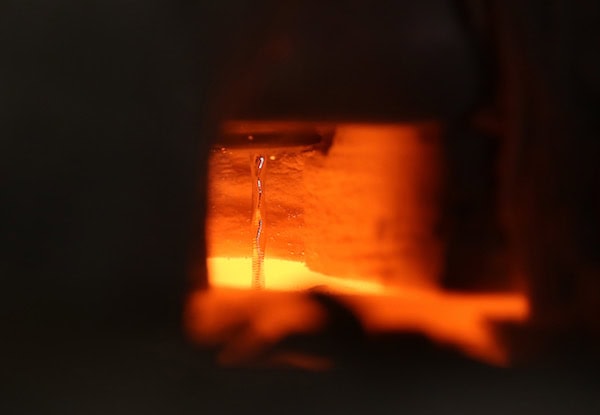
[Image above] Liquid metal flowing at 1400ºC in the laboratory of Asegun Henry at Georgia Tech. Credit: Caleb Amy; Georgia Tech
If you have a basic understanding of ceramic materials, you know that they possess superior properties of high temperature strength and melting points, extremely high hardness, high compressive strength, and dimensional stability. Depending on the specific material, they can be electrically conductive, thermally conductive, or magnetic.
That makes ceramics ideal for a number of applications, such as automotive parts that need heat-resistant characteristics and cutting tools for manufacturing that require excessive strength. The medical industry uses ceramic materials for bone and dental replacements. The aerospace industry uses ceramic materials in engines and missile nose cones to protect internal components from high heat. Ceramics contribute to environmental and solar energy industries in water treatment and power plant engines.
Ceramic materials, however, are brittle, so they have their limitations—in moving parts, for example, like a mechanical pump—and that’s why ceramics aren’t typically used in those types of applications. But that didn’t stop scientists from Georgia Tech, Purdue University, and Stanford University from building one such pump.
In a collaboration led by Asegun Henry, assistant professor at Georgia Tech’s Woodruff School of Mechanical Engineering, researchers built a ceramic mechanical pump that transfers liquid metals at extremely high temperatures. The pump can expedite high efficiency thermal storage at low cost, “providing a new way to store renewable energy generated by wind and solar power, and facilitate an improved process for generating hydrogen directly from fuels such as methane—without producing carbon dioxide,” according to a Georgia Tech news release.
Henry and graduate student Caleb Amy developed a ceramic gear pump, in which rotating gears extrude hot liquid metal (tin, in this case) through an outlet. Although liquid metals are ideal for transferring heat at high temperatures, there’s always the chance of corrosion in the infrastructure, according to the team’s paper, published in Nature.
But using ceramic materials enables higher temperatures during the pumping process—temperatures ranging between 1,473–1,673 Kelvin (2,192–2,552ºF). “Until now, we’ve had a ceiling for the highest temperatures at which we could move heat and store it, so this demonstration really enables energy advances, especially in renewables,” Henry explains in the release.

Graduate student Caleb Amy pours molten tin into a crucible. Credit: Christopher Moore, Georgia Tech
“The hotter we can operate, the more efficiently we can store and utilize thermal energy,” he adds. “This work will provide a step change in the infrastructure because now we can use some of the highest temperature materials to transfer heat. These materials are also the hardest materials on Earth.”
For their first trial, the researchers used an outside manufacturer to fabricate gears made of a ceramic called Shapal. They created seals out of graphite—a material that can withstand extremely high temperatures. (Conventional pump seals are made from polymers, which would not survive extremely high temperatures.)

Caleb Amy shows how two ceramic gears mesh in a pump developed to transfer molten tin at more than 1,400ºC. (Credit: Christopher Moore; Georgia Tech)
The pump operated for 72 hours with temperatures reaching up to 1,673 Kelvin (2,552ºF)—an initial success despite challenges in the team’s first four attempts. However, because the gears were made from a softer ceramic, they showed signs of wear.
The researchers suggest multiple applications could follow. One would be renewable energy storage for energy produced by solar or wind, using the electricity produced to heat the metal. Another use of the ceramic pump would be to produce hydrogen from methane without releasing CO2 into the atmosphere. The pump could also replace molten salts in solar power applications where corrosion is a concern.
Henry also proposes the pump could eventually be used to create an inexpensive battery. “It appears likely that storing energy in the form of heat could be cheaper than any other form of energy storage that exists,” he says in the release. “This would allow us to create a new type of battery. You would put electricity in when you have an excess, and get electricity back out when you need it.”
He and his team plan to experiment with harder and stronger ceramic materials, starting with silicon carbide. Once they find the ideal ceramic material, scaling for industry would be the next step. Henry also says their pump can operate at higher temperatures and that using molten silicon instead of tin may be less expensive for thermal storage.
Watch a brief video to learn more about the ceramic pump.
The paper, published in Nature, is “Pumping liquid metal at high temperatures up to 1,673 Kelvin” (DOI: 10.1038/nature24054).
Did you find this article interesting? Subscribe to the Ceramic Tech Today newsletter to continue to read more articles about the latest news in the ceramic and glass industry! Visit this link to get started.
Author
Faye Oney
CTT Categories
- Basic Science
- Energy
- Environment
- Manufacturing
- Material Innovations
- Thermal management


